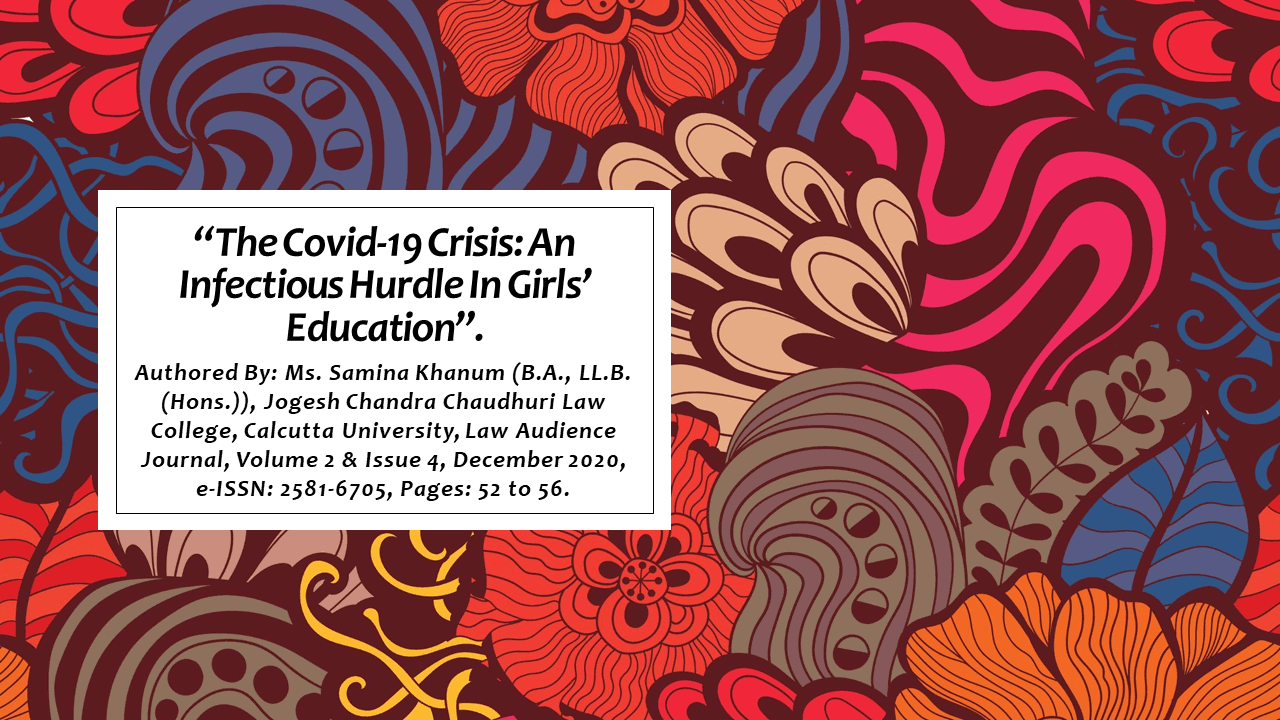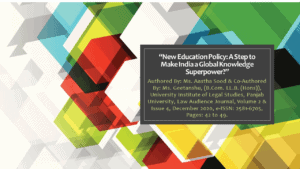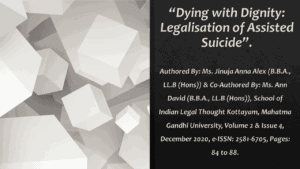Click here to download the full paper (PDF)
Authored By: Ms. Samina Khanum (B.A., LL.B. (Hons.), Jogesh Chandra Chaudhuri Law College, Calcutta University.
Click here for Copyright Policy.
Click here for Disclaimer.
I. INTRODUCTION:
For a world that is developing so rapidly that human beings are now able to create and do things that could not have been imagined even a 100 years ago, it is imperative to enquire how some of the bigger problems of the society still remain so unsolvable that colonizing Mars is a more achievable dream today than raising healthy children in a healthy environment with a good education? Have we as human beings lost sight of the greater good to such an extent that we can no longer perceive that all our advancements and all our promises for a brighter future will turn to dust if we fail to give the most important members of our society what they deserve as their basic rights.
It has been established and revisited time and again that education is the ultimate tool of empowerment, both at an individual level and for the society as a whole. In the 21st century, it is a shame that children still struggle to complete primary school. When a child is deprived of their education, society loses a potential scientist, doctor, innovator, astronaut, a change maker. Where both girls and boys are bereft of access to this extremely basic right, the scales are tipped a little more in disfavour of girls. Globally, 123 million youth aged 15 to 24 years lack basic reading and writing skills of which 61% are young women. 132 million girls are out of school all over the world, that is 132 million minds lost to society’s development and advancement. A World Bank report launched in partnership with the Malala Fund shows that if all girls completed secondary school, women and girls could add up to 30 trillion dollars to the global economy[1].
For what was already a terrible situation, the onset of a global pandemic has further aggravated the existing learning crisis and inequalities. On January 30, 2020, the Director-General of the World Health Organization (WHO) declared the novel coronavirus outbreak a global pandemic in the wake of which the world was left to grapple with a new reality. The outbreak has since changed all our lives in unexpected ways. Lockdowns all over the world brought the global economy to a standstill, millions lost their jobs, homes, and the added apprehension of an impending deadly virus accentuated the anxiety and uncertainty that people were already feeling. Schools, colleges and educational institutions shut down to curb the spread of the virus and soon shifted to remote learning which in turn reflected the frightening gaps in the access to the internet and other amenities for children.
Whereas some people have only had to adjust and cope with this seeming shift, most stand stripped of whatever little they previously had access to. In this heartbeat of a moment in which everything changed, a lot of tiny steps that had been taken in pursuit of some noble changes have also been undone. Of these, the most concerning issue has been the distortions that have been caused to the education system, especially with regard to disadvantaged and vulnerable groups.
II. IMPACT OF CLOSURE OF SCHOOLS:
The pandemic has caused an unprecedented crisis with the sudden and worldwide lockdown of schools and other educational institutions to curb the spread of COVID-19 disrupting the lives of countless students. The Secretary-General of the United Nations said, “We face a generational catastrophe that could waste untold potential, undermine decades of progress and exacerbate entrenched inequalities”. UNESCO estimates that about 24 million learners, from pre-primary to university level, are at risk of not returning to school in 2020 following the education disruption due to COVID-19[2].
Schools are still closed with no possibility of opening unless a vaccine is in the market for the virus. Almost all schools have shifted to remote learning modules over the course of the last few months. Where in developed countries such a module has been a success, the story is different in a developing country like India. Closer home, the impact of COVID-19 on education has been devastating. The pandemic has invariably widened the gender disparities and distortions in the education system. It has also reversed the accomplishments that had been made concerning girls’ education in PRE-COVID-19 times. In another report, UNESCO estimates that 158 million girls enrolled from pre-primary to tertiary levels of education have been affected by the school closures in India during the pandemic[3].
An exploration into the concerns on girls’ education in the COVID-19 context unravels deeply entrenched negative social norms and cultural practices within a patriarchal framework that perpetuate gender inequalities. Young girls bear the burden of unpaid care work, the digital divide in education, health concerns, infliction of violence, and multiple shards of vulnerabilities including poverty and loss of livelihoods of their families[4]. Moreover, the digital divide, learning gap and learning loss have made education even more inaccessible and difficult.
Attending school and physical classes in a country like India was invaluable because it offered children, especially girls, a secure parameter away from home, mid-day meals, playgrounds, extra-curricular activities and other outlets that helped nurture their minds. It also offered them physical safety and protection from abusive families, forced child-labour, malnutrition. Due to school closure, this safe haven is now inaccessible once again.
Where remote learning is the only alternative to physical classes at such times, it is to be remembered that the digital divide in India is huge. Only 10.9% of households in India have internet access. Internet access to rural households (5.7%) is much below the national average. The poor access to electronic gadgets is another major hindrance, where some households do not have any electronic gadgets; most can afford only a single device. As such, the gender disparity becomes active and apparent in the face of such situations where boys are given preferential treatment. UNESCO has warned that we could see the reversal of 20 years of gains made for girls’ education.
III. HOW WILL THIS SETBACK BE REMEDIED?
The pandemic has revealed that India’s education system lacks in preparedness to cope with ensuring the continuity of education in the face of adversities. The mere closure of schools has now endangered the education of millions of students of which many will not return to school POST-COVID-19 if appropriate measures are not taken to address the issue. With the pandemic raging on, the stakes are higher. Missing out on education has serious personal and collective repercussions.
It is imperative to strengthen the education system from its core and focus on changing and addressing the issues that sit at the heart of perpetrating exclusion and gender disparity. The education system should be curated in a manner that is conducive to learning and easy to access. Also, efforts must persist to remove the barriers to education, pre-existing the pandemic, which prevents millions of children and youth from accessing and benefiting from quality education.
Governments, civil society organizations and other partners should also work to address the factors that pull learners out of education systems through further strengthening awareness on the right to education, advocating on the importance of education for sustainable livelihoods and personal, social and economic empowerment. Collaboration among all stakeholders should be reinforced to ensure social demand for education and address disengagement, engaging with finance and other concerned ministries to advocate that resources allocated to education are in fact an investment and a long-term solution for economic recovery and growth.[5] UNESCO is imploring countries worldwide to join the global education coalition campaigns #BacktoSchool and #LearningNeverStops to facilitate international and national cooperation to ensure an end to this education crisis so that no child is left behind, COVID-19 or no COVID-19.
IV. CONCLUSION:
People across the world are coming to terms with a “new normal.” Children are coping with a life without school. For most, it will be a temporary hiatus from which they will emerge, perhaps with greater respect for the teaching profession and a reinvigorated love of learning. But for millions of girls, its risks being more than just an interruption if governments do not heed the lessons of past crises and do all they can to implement gender-sensitive responses to the current and future education challenges their countries to face. Girls from Lebanon to Pakistan to Ethiopia have conveyed that education shields them from violence, mitigates against harmful gender norms and gives them hope for the future[6].
Learning from the past and planning now for the future will enable education systems to recover quickly and serve the most marginalised girls and boys[7]. The current crisis must be dealt with effectively so that we may not fail the future generations and help them hold fast to their dreams.
[1] UNESCO, School, health and nutrition: Why COVID-19 demands a rethink of education to address gender inequalities, (Sept. 02, 2020), https://en.unesco.org/news/school-health-and-nutrition-why-covid-19-demands-rethink-education-address-gender-inequalities.
[2] UNESCO, How many students are at risk of not returning to school?, Advocacy Paper (2020).
[3]UNESCO, Keeping Girls in the Picture (2020).
[4] Rajini Menon, Closure Of Schools In The Pandemic Has Robbed Many Girls Of Safe Space, YOUTH KI AWAAZ (Oct. 13, 2020), https://www.youthkiawaaz.com/2020/10/solidarity-to-girls-on-this-international-girl-child-day/#_ftn1.
[5] UNESCO, Keeping Girls in the Picture (2020).
[6] Malala Fund (2016) Not Lost: Claiming Syria’s Future. https://assets.ctfassets.net/ xnpfvoz3thme/2tsXGP1QKQsCOKcKKsuqKi/8728032fa34ce1a7239a2089de28a245/NotLost_Report.pdf
[7] Malala Fund (2020). Girl’s education and COVID-19: What past shock can teach us about mitigating the impact of pandemic, GirlsEducationandCOVID19_MalalaFund_04022020.pdf.



